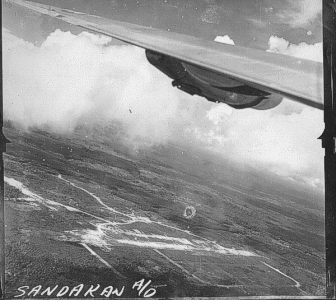![]() The Pacific War Online Encyclopedia
The Pacific War Online Encyclopedia
|
| Previous: Sand Point | Table of Contents | Next: Sanderson, Lawson H.M. |

U.S. Air Force. Via far-eastern-heroes.org.uk
Sandakan (118.123E
5.850N) is a small port on the
northeast tip of Borneo.
In 1941, it was the capital of British
North Borneo and had a population of about 13,800. The port had just
enough facilities to load oil
from the nearby fields, which produced about two million barrels a
year. The city had an airstrip
but no significant garrison when war broke out. It was seized by by
elements of 55
Brigade Group and 2 Yokosuka Special Naval Landing Force
on 17 January 1941.
Sandakan Death Marches. The Japanese transported a large number of British and Australian prisoners of war from Singapore to Sandakan, where they were joined by civilian laborers from Java. Between January and May 1945, the Japanese, fearing that the prisoners might be liberated, marched them in three groups into the interior of Borneo to a new camp at Ranau, near Mount Kimabula. The prisoners were already in very poor condition from lack of food and other mistreatment, but were forced to carry the equipment of their guards along with their own supplies. Those who fell out were immediately shot. Out of approximately 1900 prisoners who began the march, just 220 made it to Ranau, and only 38 of these were still alive at the end of July. All but six were executed twelve days after the general Japanese surrender. The remaining six escaped into the jungle, were aided by the indigenous population, and eventually returned to Allied lines. Of these, three did not recover from their ordeal, but the remaining three testified before the Tokyo and Rabaul military tribunals. These were the only survivors of some 2776 prisoners originally transported to Sandakan.
Z Special Unit actually planned an operation, KINGFISHER, to rescue the prisoners at Sandakan. Whether MacArthur or Blamey
was responsible for the dithering and indecision that prevented the
operation from ever taking place has been hotly contested by historians.
The town was not reoccupied by the Allies until 19 October 1945, nine weeks after the Japanese surrender. By then the town had been leveled by Allied bombers.
References
Australia's War: 1939-1945 (accessed 2008-5-25)
Rottman
(2002)
The
Sandakan Death March (accessed 2009-5-25)
The Pacific War Online Encyclopedia © 2007, 2009, 2011 by Kent G. Budge. Index